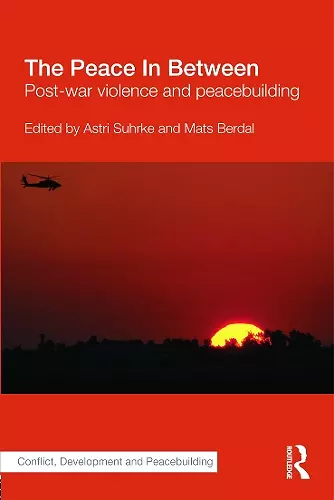The Peace In Between
Post-War Violence and Peacebuilding
Astri Suhrke editor Mats Berdal editor
Format:Paperback
Publisher:Taylor & Francis Ltd
Published:3rd Jul '12
Currently unavailable, and unfortunately no date known when it will be back
This paperback is available in another edition too:
- Hardback£160.00(9780415609326)

This volume examines the causes and purposes of 'post-conflict' violence.
The end of a war is generally expected to be followed by an end to collective violence, as the term ‘post-conflict’ that came into general usage in the 1990s signifies. In reality, however, various forms of deadly violence continue, and sometimes even increase after the big guns have been silenced and a peace agreement signed. Explanations for this and other kinds of violence fall roughly into two broad categories – those that stress the legacies of the war and those that focus on the conditions of the peace. There are significant gaps in the literature, most importantly arising from the common premise that there is one, predominant type of post-war situation. This ‘post-war state’ is often endowed with certain generic features that predispose it towards violence, such as a weak state, criminal elements generated by the war-time economy, demobilized but not demilitarized or reintegrated ex-combatants, impunity and rapid liberalization.
The premise of this volume differs. It argues that features which constrain or encourage violence stack up in ways to create distinct and different types of post-war environments. Critical factors that shape the post-war environment in this respect lie in the war-to-peace transition itself, above all the outcome of the war in terms of military and political power and its relationship to social hierarchies of power, normative understandings of the post-war order, and the international context.
This book will of much interest to students of war and conflict studies, peacebuilding and IR/Security Studies in general.
'Postwar peace is never easy and only rarely fully consolidated. In this important new collection of wide-ranging case studies, editors Astri Suhrke and Mats Berdal demonstrate the added-value of disaggregating peaces into four distinct categories -- peace imposed by victors, challenged by losers, accepted by parties and divided among factions. They show how each has its own challenges and why confusing them can be fatal to mitigating conflict.' - Michael Doyle, Columbia University
'This book has been sorely needed and will be widely read. It is commonplace to cite examples like El Salvador where post-war levels of violence have been high. But we have not had anything remotely approaching the systematic bringing together of evidence, historical and more recent, confirming how generalised is the phenomenon of post-war violence.’ - Christopher Cramer, School of Oriental and African Studies, University of London
'This volume does a superb job of investigating a question that is critically important both to scholars and policy practitioners: what causes the violence that often continues, in various forms, after the formal termination of wars?' - Roland Paris, University of Ottawa
"[S]uccessfully analyses different forms of peace and provides a nuanced picture of the nature of peace in between. The book provides a good overview of the state of the art, as well as several interesting case studies. It should be of great interest to both students of peace and conflict students, as well as policy makers." - Anna K. Jarstad, Uppsala University, Sweden
"The book is well constructed and logical. The reference list is extensive and is of direct benefit to students of international relations, strategic studies and political science. It is also of benefit to lecturers, seeking to provide students with a broader perspective on post-war conflict and violence." -Jack Newnham and Peter Bell, Queensland University of Technology, Australia
ISBN: 9780415680592
Dimensions: unknown
Weight: 650g
352 pages